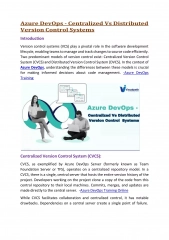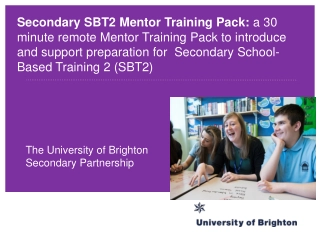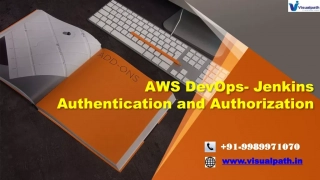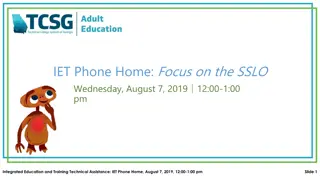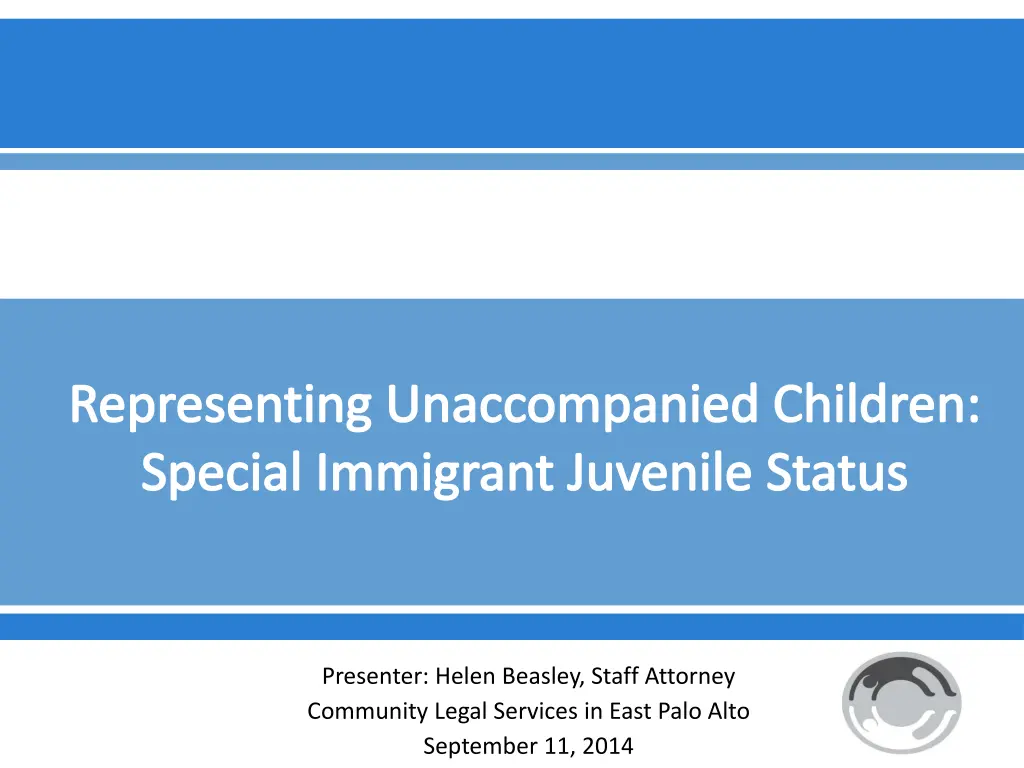
Special Immigrant Juvenile Status Presentation by Helen Beasley at Community Legal Services
Get insights into representing unaccompanied children and Special Immigrant Juvenile Status from the informative presentation by Helen Beasley, Staff Attorney at Community Legal Services in East Palo Alto. Learn about the basics, government agencies, definitions, the need for immigration legal services, best practices for working with children, and general considerations. Understand the complexities and nuances of immigration law when dealing with minors in removal proceedings.
Download Presentation

Please find below an Image/Link to download the presentation.
The content on the website is provided AS IS for your information and personal use only. It may not be sold, licensed, or shared on other websites without obtaining consent from the author. If you encounter any issues during the download, it is possible that the publisher has removed the file from their server.
You are allowed to download the files provided on this website for personal or commercial use, subject to the condition that they are used lawfully. All files are the property of their respective owners.
The content on the website is provided AS IS for your information and personal use only. It may not be sold, licensed, or shared on other websites without obtaining consent from the author.
E N D
Presentation Transcript
Representing Unaccompanied Children: Special Immigrant Juvenile Status Presenter: Helen Beasley, Staff Attorney Community Legal Services in East Palo Alto September 11, 2014
Basic Overview of Representing Clients in Removal Proceedings
Immigration, ICE, La Migra: Who Are the Government Agencies Involved? Overview of Federal Immigration System for Unaccompanied Minors * SOURCE: http://www.vera.org/download?file=3483/the- flow-of-unaccompanied-children-through-the- immigration-system.pdf
Definitions Slide o Notice to Appear: charging document in immigration court proceedings; issued by the Department of Homeland Security and then filed with the Immigration Court to commence removal proceedings o Office of the Chief Counsel ( OCC ): acts as the prosecutor in immigration court; part of Immigration and Customs Enforcement, Office of the Principal Legal Advisor o FOIA: Freedom of Information Act; used to obtain copy of client s file from DHS and EOIR
Need for Immigration Legal Services o 3909 unaccompanied children were released to sponsors in California from January 1 July 31, 2014 o Released children to the Bay Area: Alameda: 242 San Francisco: 185 San Mateo: 153 Santa Clara: 132 Marin: 96 Contra Costa: 91 o 58% of juveniles who are represented in San Francisco Immigration Court are able to stay in the United States o 14% of juveniles who are unrepresented in San Francisco Immigration Court are able to stay in the United States
General Considerations o Many of these children have been victims of trauma o Need to take into account child s capacity to understand and communicate Language Education Level Chronological and developmental age Mental health issues
Tools to Assist Communication o Use simple, child-friendly language Speak in short, simple sentences Slow down your rate of speech Avoid double negatives and compound sentences Use culturally appropriate analogies o Incorporate visual aids Diagrams Drawings o Be mindful of non-verbal communication o Ask child to repeat information back to you
Attorney-Client Relationship with Child o The child (not the adult) is the client o The attorney owes the same duties to the child as to an adult client, including: Confidentiality Communication Zealous Advocacy o Attorney must represent the child s stated interest, not his or her best interest
Before the Interview o Obtain as much information as possible about the case prior to meeting with the client Review all documentation sent by referring legal service provider o Briefly meet with both the child and their parent/guardian/sponsor to explain that the child is your client and your duty of confidentiality, then meet alone with the child
At the Beginning of the Interview o Clearly explain your role to the child o Explain the purpose of the meeting o Explain what information you have and where you got it from o Set guidelines for the meeting E.g., that it s ok for the child to say I don t know or I don t remember ; that the child can tell you if he or she doesn t want to talk about a certain topic or needs to take a break
During the Interview o Ask open-ended questions, rather than leading or direct questions E.g., Tell me about your journey to the U.S. , rather than Was your journey to the U.S. difficult? o Give child time to answer questions without interrupting him or her o Give space for the child to expand or clarify information that you already have o Avoid using labels that reflect judgment; instead repeat back terms/phrases that child used
At the End of the Interview o Ask if the child has any questions o If necessary, obtain child s permission to share information or speak with an adult about the case o Clearly explain next steps Who is responsible for what Give child information about what he or she needs to do in writing Timeline
Sources of Law for SIJS o INA 101(a)(27)(J) o INA 245(h) o 8 C.F.R. 204.11* o Trafficking Victims Protection Reauthorization Act of 2008 (TVPRA 2008), Pub. Law. 110-457 235(d)(1)-(3), 122 Stat 5044 o Perez-Olano Settlement Agreement *Note: Federal regulations have not been updated since major changes to SIJS by TVPRA 2008
SIJS is a 3-step process Step Three: Residency Application Step One: State Court Step Two: SIJS Petition
Basic Requirements of SIJS o Present in the U.S. o Under 21 at time of filing o Unmarried o Dependent on juvenile court OR placed in the custody of an individual/entity or state department/agency by a state court o Reunification with one or both parents not viable due to abuse, abandonment, neglect, or a similar basis under state law o Not in child s best interest to be returned to country of nationality or last residence
State Court Requirement o Juvenile Court: a court located in the U.S. having jurisdiction under State law to make judicial determinations about the custody and care of juveniles (8 C.F.R. 204.11(a)) o In California: Juvenile court Dependency (foster care) Delinquency (juvenile arrests) Probate court (guardianship) Family court (divorce, paternity, custody)
Reunification Finding: Examples o Child is living with mom and has never had any relationship with dad o Child is living with older sister and mom is deceased o Child and mom fled to U.S. to escape abusive dad o Child was abandoned by parents and is living with grandmother o Child was forced to drop out of school and work by parents, and is now living with aunt
Best Interest Finding o Look at child s situation in U.S. as compared to home country o Factors: Stable living environment Support system / family or community ties Safety concerns Educational and career opportunities Access to necessary services (medical, mental health, etc.)
Benefits and Drawbacks of SIJS o Benefits: Generally do not have to testify about trauma in court or to USCIS officer Fast pathway to residency As a resident, can work and live legally in U.S. and can travel abroad for limited periods of time Access to public benefits After 5 years, can apply for citizenship o Drawbacks: Can never petition for either parent No derivative beneficiaries May have to serve parents and other family members with request for state court order
Step One: Obtaining the SIJS Predicate Order from State Court
Objectives in State Court o Two main objectives in state court: Have child under state court jurisdiction Obtain SIJS predicate order o How to open a state court case will depend on child s situation Living with a non-parent: file guardianship petition in probate court Living with one parent: file paternity, divorce, or custody suit in family court May already have a preexisting delinquency or dependency case in juvenile court
Filing the Guardianship Petition o Please see the Guardianship Pro Bono Manual on our website for a step-by-step guide on how to file the guardianship petition
Request SIJS Predicate Order o Can file request for SIJS predicate order at the same time as state court action o Elements of SIJS Predicate Order Request: Petition for SIJS Factual Findings Memorandum of Points and Authorities Evidence Supporting SIJS Factual Findings Proposed Order Proof of Service
Petition for SIJS Factual Findings o Motion that requests the order from the court o Includes brief overview of basis for SIJS factual findings o Specifies what you want the court to do (i.e., issue specific factual findings) o Not all jurisdictions require a separate petition; may be combined with Memorandum of Points and Authorities In San Mateo County, file a separate petition for factual findings
Memorandum of Points and Authorities o Provides overview of SIJS requirements and how child meets those requirements o Sample sections: Introduction / Overview of SIJS Law Factual Summary Argument Court is a juvenile court for SIJS purposes Child dependent on the court for SIJS purposes Reunification not viable Not in child s best interest to be reunified
Evidence Supporting SIJS Findings o Must provide evidence of abuse, abandonment, or neglect, and of child s best interests, if not already in the court record o Types of evidence: Child s affidavit (generally sufficient evidence) Affidavit(s) of parent or other caregiver(s) with personal knowledge of facts Affidavit of social worker Psychological evaluation, medical records, etc. Death certificate of parent(s) Child s school records
Proposed Order o Probate Court: Judicial Council Form GC-224 o Juvenile Court: Judicial Council Form JV-224 o Family Court: no judicial council form; must write proposed order o Tip: include brief basis for SIJS findings as attachment 4 to JV-224 or attachment 5 to GC-224 E.g., Minor was abandoned by father and abused by mother
Proof of Service o Service rules vary by jurisdiction o In San Mateo County, serve request for SIJS factual findings in same manner as guardianship petition Personally serve parent(s), or obtain waiver of notice; AND Serve by mail proposed guardian(s), grandparents, and siblings (full and half) (i.e., all parties who receive notice of guardianship petition) o Must file proof of service and/or waiver of service
Age-Out Issues o State court process may take several months o If minor is close to turning 18, investigate whether SIJS order can be issued on expedited basis E.g., in San Francisco Probate Court, can request SIJS findings on basis of temporary guardianship E.g., in San Mateo Juvenile Court, can request order shortening time for service to allow for faster hearing date In San Mateo Probate Court, cannot request SIJS order on expedited basis at this time
Documents for SIJS Petition o Cover letter o Case summary (from attorney or social worker) o Form G-28 o Form I-360 o Certified copy of state court SIJS predicate order o Proof of age
Case Summary o Brief declaration from attorney or social worker summarizing evidence that was basis for SIJS factual findings o Sworn under the penalty of perjury o Do not need to get into a lot of detail E.g., Child was born on [DATE] to [PARENTS]. Child never had a relationship with dad. Child lived with mom in [COUNTRY]. Child had to stop attending school last year because of gang violence in neighborhood. Child came to U.S. to escape gang violence and to pursue education. Child is now living safely with aunt and is in 9th grade at [SCHOOL]. On [DATE] the [COUNTY] Probate Court appointed aunt as legal guardian of child.
Proof of Age o Best proof of age: birth certificate with certified English translation o If birth certificate not available, can use other proof of age Medical records Early school records Baptismal certificate or other religious records Affidavits (personal knowledge of birth) Bone density or dental exam (last resort) o Will need to submit declaration as to why birth certificate not available and efforts made to obtain birth certificate
Submission of SIJS Petition o SIJS petition is adjudicated by U.S. Citizenship & Immigration Services o Currently all SIJS petitions are submitted to USCIS Chicago Lockbox o Do not need a fee or a fee waiver for stand-alone SIJS petition
Timing of SIJS Petition o Submit SIJS petition while child under jurisdiction of state court and under 21 years of age o Should submit SIJS petition as soon as possible after obtaining state court SIJS predicate order o USCIS has 180 days to adjudicate SIJS petition
Adjudication of SIJS Petition o Biometrics: at this time, San Francisco Field Office requires biometrics for stand-alone SIJS petitions; San Jose Field Office does not Make sure to clearly explain biometrics appointment to child If under 18, can generally use student ID
Adjudication of SIJS Petition o Interview: at this time, both San Francisco and San Jose Field Offices require interviews for stand-alone SIJS petitions Bring any documents requested to interview Do not submit state court filings (i.e., request for SIJS order) May have to submit copy of Letters of Guardianship Interview should NOT require child to discuss basis for SIJS factual findings (i.e., details of abuse, abandonment, or neglect)
Admissibility for Special Immigrant Juveniles o To become a resident, must be admissible to the United States o Many common grounds of inadmissibility do not apply to Special Immigrant Juveniles o Other grounds of inadmissibility are waivable for Special Immigrant Juveniles o See INA 245(h)
Inapplicable Grounds of Inadmissibility o Present in U.S. without admission or parole (INA 212(a)(6)(A)) o Likely to become public charge (INA 212(a)(4)) o Fraud / misrepresentation (INA 212(a)(6)(C)) o False claim to U.S. citizenship (INA 212(a)(6)(C)) o Not in possession of valid entry document (INA 212(a)(7)(A)) o Stowaways (INA 212(a)(6)(D)) o Labor certification (INA 212(a)(5)(A)) o Three and ten year bars (INA 212(a)(9)(B))
Waivable Grounds of Inadmissibility o Health-related grounds (INA 212(a)(1)) o Prostitution and commercialized vice (INA 212(a)(2)(D)) o Failure to attend removal proceedings (INA 212(a)(6)(B)) o Smugglers (INA 212(a)(6)(E)) o Individuals previously removed (INA 212(a)(9)(A)) o Permanent bar (INA 212(a)(9)(C)) o Miscellaneous grounds (INA 212(a)(10))
Waivable Grounds of Inadmissibility o Standard for SIJS waiver: For humanitarian purposes, family unity, or when it is otherwise in the public interest o Relatively generous waiver standard o Does not require a qualifying relative or hardship
Problem Grounds of Inadmissibility o Criminal and terrorism-related grounds of inadmissibility (INA 212(a)(2)(A)-(C) and (3)(A)-(C) and (E)) either cannot be waived or are subject to a higher waiver standard o Remember: juvenile delinquency adjudications are NOT criminal convictions for immigration purposes (Matter of Devison-Charles, 22 I&N Dec. 1362 (BIA 2000)(en banc)) o RED FLAG: drug trafficking
Obtain a Copy of Clients Immigration Files o To anticipate potential issues, make sure to get a copy of your client s A file before submitting the residency application o If in removal proceedings, submit Track Three expedited FOIA request to USCIS (must include copies of Notice to Appear and Hearing Notice) o If client was in ORR custody, he or she will have a separate file with ORR o Submit a request for a copy of the ORR file: http://www.acf.hhs.gov/programs/orr/resource/requests-for-uac-case-file- information
Who adjudicates residency application? o If not in removal proceedings, can submit residency application to USCIS at the same time as SIJS petition o If in removal proceedings, depends on how the child was charged If properly charged as arriving alien, can submit residency application to USCIS at the same time as SIJS petition If properly charged as present in U.S. without admission or parole, need to either submit residency application to Immigration Court or terminate removal proceedings and then submit to USCIS
Terminating Removal Proceedings o Need to get agreement of the Office of the Chief Counsel (OCC) to terminate removal proceedings o May be able to get agreement of OCC once state court issues SIJS predicate order or after SIJS petition is approved by USCIS o If OCC agrees, submit joint or unopposed motion to terminate removal proceedings without prejudice to Immigration Judge o Immigration Judge needs to grant order terminating removal proceedings before child can submit residency application to USCIS
Documents for Residency Application o Cover letter o Form I-912, fee waiver request with supporting evidence o Form G-28 o Form I-485 o Form G-325A o Form I-765 o 4 passport style photographs o Form I-693, Medical Exam Results (may be submitted at interview) o Copy of photo ID (preferably passport of consular ID) o I-360 Approval Notice or Receipt Notice, if available (based on timing of residency application o Copy of Immigration Judge s order terminating removal proceedings (if applicable)






